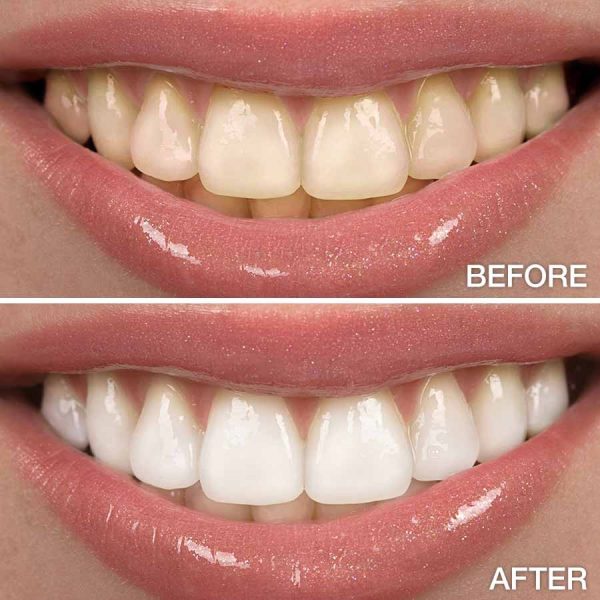Tooth Whitening:

Bleaching is a procedure used for teeth whitening. Shiny, brighter teeth are symbol of youth and are aesthetic pleasing.
Indications of Tooth Whitening:
Bleaching creates youthful appearance by changing color (shade) of your teeth to lighter shade. Ideally shade of teeth should match with Scalera (white part) of eye to create facial symmetry. Intrinsic discoloration and staining are removed by bleaching without any harmful effects on teeth.
With ageing, there is yellowing of natural tooth. Teeth whitening in this case create youthful appearance by changing tooth shade to lighter one.
Patient may have good quality crown placed long time ago with excellent shade match with adjacent teeth. With ageing, there is yellow discoloration of natural teeth while artificial crown color (shade) remains same.
When there is mismatch between shade of natural teeth and crown with crown lighter in shade then natural tooth, there are two options: bleach teeth to make it lighter to match with crown shade or change crown to darker shade to match natural tooth. Bleaching is preferred in such case.
Indications of Bleaching can be Summarized Below:
- Yellow discoloration of ageing teeth.
- Smoking and dietary stains such as those of tea and coffee that internalized into tooth
- Dental fluorosis – fluorosis with multiple brownish spots, patches on teeth responds well to whitening;
- Tetracycline staining –Tetracycline staining is difficult to treat with bleaching. Bleaching may not remove stains fully but will improve dramatically that many patients accept it.
- Single tooth discoloration caused by pulpal necrosis, pulpal hemorrhage, RCT responds well to bleaching.
What are the Contraindications of Bleaching?
- Unrealistic expectation and demand that miracle happen.
- Active and chronic infection. Tooth decay (caries), gum disease and poor oral hygienic.
- Pregnancy.
- Tooth sensitivity. Sensitivity should be controlled before bleaching.
- Multiple filling and crown in the anterior aesthetic zone. Teeth responds to bleaching and become whiter after bleaching but existing filling and crown don’t respond to bleaching and so there is contrast in shade between teeth and previous filling. So existing crowns or fillings need to be changed following bleaching.
- Gum shrinkage (recession) with visible yellow roots that do not response well to bleaching.
- Gummy smile and poorly aligned teeth that become prominent when whiter, shiny teeth spark in oral cavity.
- Age: Age below 16 years because large pulp chamber.
What are Factors that Affect the Success of Tooth Whitening?
- Age: young teeth response well to bleaching.
- Type of bleaching: Home based bleaching by carbamide peroxide-based produce long lasting aesthetic result as compared to chair side bleaching by hydrogen peroxide.
- Concentration of bleaching agent: It’s advised to use recommended concentration of bleaching to avoid any side effects. Higher concentration increases the bleaching rate up to certain limit but it has side effects like tooth sensitivity.
- Type of discoloration and severity of discoloration.
- Patient compliance to wear tray in home beaching tray.
- Use of light. Bleaching agents bleach the teeth not light or laser. Light only activates bleaching gel to do bleaching in less time. Laser may be used to activate bleaching agents but is not recommended because of side effects.
What are the Side Effects of Bleaching?
Bleaching has no significant side effects. In few patients there is sensitivity during bleaching. Sensitivity recovers easily after bleaching. Accurate treatment plaining and use of fluoride and potassium nitrate is key to control sensitivity.
What is the Procedure for Bleaching?
Chairside (at clinic) and at home procedure are used for teeth whitening. In chair side hydrogen peroxide gel is used for teeth bleaching and at home carbamide peroxide in bleaching tray is used that release hydrogen peroxide. Both procedures are effective.
Chair side (at clinic) responds speedy to bleaching and need 2 to 3 visits. At home responds slowly and may take 15 days and tray loaded with carbamide peroxide have to wear 8 hours a day. At home bleaching uses chemical in low concentration.
Simple light (or laser) may be used to accelerate chair side bleaching that is often referred as laser bleaching. Laser itself don’t not bleach the teeth; it accelerates the chemical reaction of bleaching agent to perform better.

